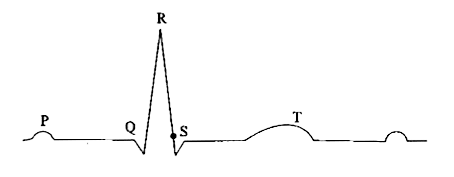Given here is an ECG of a normal human. Which one of its components is correctly interpreted?

A
QRS comples—one complete pulse
B
Peak T-initiation of total cardiac contraction
C
Peaks P and R-systole and diastole blood pressure
D
Peak T-initiation of left atrial contraction only
Text Solution
The correct Answer is:A
Obviously, by counting the number of QRS complexes that occur in a given time period, one can de termine the heartbeat rate of an individual.
Since the ECGs obtained from different individuals have roughly the same shape for a given lead con figuration, any deviation from this shape indicates a possible abnormality or disease. Hence, it is of a great clinical significance.
|
Updated on:21/07/2023
Similar Questions
Knowledge Check
- Question 1 - Select One
The given figure is the ECG of a normal human. Which one of its components is correctly interpreted below ?
 AComplex ORS - one complete pulseBPeak T - initiation of total cardiac contractionCPeak P and peak R together - systolic and diastolic blood pressuresDPeak P- initiation of left atrial contraction only
AComplex ORS - one complete pulseBPeak T - initiation of total cardiac contractionCPeak P and peak R together - systolic and diastolic blood pressuresDPeak P- initiation of left atrial contraction only - Question 2 - Select One
Given below is the ECG of a normal human. Which of its components is correctly interpreted below ?
 APeak P and Peak R together - Systolic and Diastrolic blood pressuresBPeak P- Initiation of left atrial contraction only.CComplex QRS- One complete pulseDPeak T- Initiation of total cardiac contraction
APeak P and Peak R together - Systolic and Diastrolic blood pressuresBPeak P- Initiation of left atrial contraction only.CComplex QRS- One complete pulseDPeak T- Initiation of total cardiac contraction - Question 3 - Select One
The given figure is the ECG of a normal human. Which one of its components is correctly interpreted below ?
 APeak P and Peak R together - Systolic and Diastrolic blood pressuresBPeak P= Initiation of left atrial contraction only.CComplex QRS- one complete pulseDPeak T- Initiation of total cardiac contraction
APeak P and Peak R together - Systolic and Diastrolic blood pressuresBPeak P= Initiation of left atrial contraction only.CComplex QRS- one complete pulseDPeak T- Initiation of total cardiac contraction
The given figure is the ECG of a normal human. Which one of its components is correctly interpreted below ?
 View Solution
View SolutionThe given figure is the ECG of a normal human. Which one of its components is correctly interpreted below ?
 View Solution
View SolutionWhich of the following reactions are correctly interpreted?
View SolutionWhich of the following reactions are correctly interpreted?
View SolutionWhich one of the following is correct for a normal human?
View Solution

